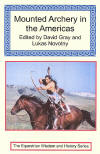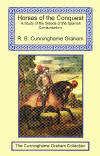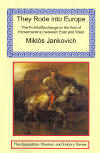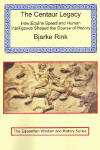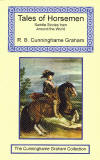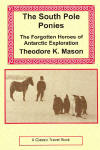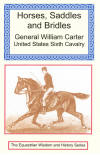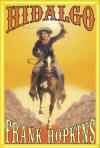The Equestrian Wisdom and History Literary Collection
- page 2
| Mounted Archery in the Americas |
This fascinating and amply illustrated book charts the history of mounted archery from its ancient roots on the steppes of Eurasia thousands of years ago to its current resurgence in popularity in the Americas. It also provides the reader with up-to-the-minute practical information gleaned from a unique team of the world’s leading experts. Mounted archery is shooting the bow and arrow from horseback at the canter and after a century and a half of neglect on the Great Plains of North America, interest in this thrilling activity is rapidly spreading from the Arctic Circle to the Tropic of Capricorn. This is the story of the reappearance of this exciting discipline in the Americas. Horseback archery has its origins in two of the great grasslands of the world—the United States Great Plains, and the vast steppes of Eurasia. As far back as 3,000 years ago Asian mounted warriors thundered down on their enemies in lightning surprise attacks, loosing showers of arrows which stunned and hopelessly dissembled their pedestrian opposition. The horseback archery culture of the American Indians reached a similar level of development and sophistication, but emerged much later and was a shorter phenomenon. Horses spread north from the Spanish colony of Mexico through the Plains beginning in the mid 1600’s, but this dynamic equestrian culture virtually vanished with the demise of the buffalo in the mid 1800’s. Yet this mounted tradition was
revived when, in 1998, Kassai Lajos, the legendary Hungarian founder of the
modern standardized discipline of mounted archery, came to the United States
for now-legendary demonstration. The world’s leading mounted archer returned
for three subsequent training camps which inspired many others to take up
the sport. Since then, mounted archery has spread with great enthusiasm
across the United States, Canada and South America. This challenging and
engaging discipline is promoted by the Mounted Archery Association of the
Americas, and the royalties from this ground-breaking study of this ancient
equestrian art are being donated to this Association. |
|
Horses Roger Pocock
|
Roger Pocock’s life reads like a fairytale full of adventure. A childhood cut short to go to sea, then service with the Canadian North West Mounted Police in 1885, followed by stints as a war correspondent, Yukon gold miner, South African army scout, and “missionary to hostile tribes.” In between he formed the Legion of Frontiersmen, organized the original World Flight by airplane and was the first person in history to ride the length of the infamous Outlaw Trail. When he was wasn’t seeking excitement, Pocock could be found writing. Though most of the prolific author’s work predictably revolved around the exciting episodes of his own life, or the other men of action he knew, Pocock’s most famous foray into academic study was his rightfully famous book, “Horses.” In today’s equine-friendly world it is difficult to imagine how revolutionary Pocock’s observations about horses were at the time. A lifelong student of equine behaviour, Pocock set out to document the wisdom of his age into a book unique for its time. His concerns for attempting to preserve equestrian knowledge were based on cruel reality. More than 300,000 horses had been destroyed during the recent Boer War. To make matters worse, “Horses” was penned by Pocock while he was serving with the British army, stationed behind the trenches during the First World War. With bombs bursting overhead, Pocock poured onto these pages the things his equine friends had taught him. “If one thinks of a horse as a little child, one cannot go far wrong.” “When my horse forgets his manners, I examine my conduct to find where I am to blame.” “The human mind may be likened unto a stable with horses all in a row. That strong team Tradition and Custom are overworked. Bias and Prejudice have plenty to do. Passion and Vice get an occasional airing, and Vanity has daily exercise. But Reason is kept in his stall. He is not popular with the other horses. Let us try him.” Though Pocock enjoyed a reputation for dangerous living, his observations on horses were praised by the leading thinkers of his day. Professor Cossar Ewart, whose study on the origin of horses drew positive praise from Charles Darwin, wrote the Preface to Pocock’s book. Here then is a true “lost masterpiece” of equestrian study, penned by one of the most unique men ever to mount a horse or lift a pen.
For more information, please visit Barnes & Noble or Amazon.co.uk. |
| Horses of the
Conquest R. B. Cunninghame Graham |
In this modern-day era, with its inherent safeties and pasturised heroes, how difficult it is to relate to the bold men and their brave horses who came to the New World. Much has been written about those Europeans known as the Conquistadors. Beginning with Columbus in the late 15th century, Iberian horses accompanied their riders across turbulent seas, over miles of mountain trails, through steaming jungles, and into cities of golden splendour. These saddle-borne conquerors were quick to admit that, after God, they owed their good fortune to their horses. Many books have recorded or reviled the Conquistadors. No book ever equalled this equine account of the horses that helped them make history. The author, Don Roberto Cunninghame Graham, was uniquely qualified to pen such an important equestrian tale. Born in 1852 to a aristocratic Scottish family, Cunninghame Graham spent his youth working as a gaucho in Argentina, before becoming an outspoken Member of Parliament in London. A lifelong horseman, Don Roberto was also one of the first European writers to defend the rights of native peoples.
Fluent in Spanish, Cunninghame Graham did extensive research
into Spain’s archives, thereby discovering manuscripts which had lain unread
for centuries. The result was a book written, Don Roberto says, out of
gratitude to the horses who shaped history. Amply illustrated with drawings
of period horses, their riders and various pieces of equestrian equipment,
“Horses of the Conquest” remains one of the most important equestrian books
ever published. |
| They Rode into Europe Miklós Jankovich (Translated by Anthony Dent) |
While the average history book is full of dates and events, or battles and inventions, such books are generally penned by pedestrians who lack the equestrian insight necessary to accurately comprehend, study and comment on the impact Central Asian mounted culture had on the development of European society. Yet this remarkable book combines the academic excellence of two of the 20th century’s leading equestrian experts. The result is the astonishing They Rode Into Europe. It was written by the famed Hungarian horseman and author, Miklos Jankovich. The author, who had access to records in the Magyar language beyond the reach of most Western European researchers, used a vast array of little-known historical information to create a coherent, comprehensive and authoritative picture of the relationship between mounted cultures from the earliest times to the late twentieth century. The translator, Anthony Dent, was rightly considered to be one of England’s finest equestrian scholars. This very well-known writer on horses supplemented the amply illustrated text with his own interpolations (marked as such) in those passages which have a special bearing on Britain and North America. Together, Jankovich and Dent created an equestrian study of unparalleled importance. The history of the world was shaped to a large extent by men on horseback who, because of the animals under them, were able to travel great distances, thus bringing about that exchange of ideas and inventions which is a fundamental requisite of human progress. Thanks to the work of these two equestrian academic pioneers, the result of their research in the fields of history, ethnology, archaeology and the study of the horse, is once again available in a readable work which explains how horses played a central role in man’s cultural, social, and economic development.
For more information, please go to Amazon.co.uk or Barnes & Noble. |
|
The Centaur Legacy
Bjarke Rink |
This immensely entertaining and historically important book provides an in-depth study into how man’s partnership with his equine companion changed the course of history and accelerated human development. It took a cultural nomad and intellectual maverick such as Bjarke Rink, who was born in Denmark and now live in Brazil, to think outside the box of traditional equestrian theology. The dedicated horseman spent years studying the symbiotic blending of human intellect and equine speed, documenting how these two unique life-forms connect to each other to create a superior being — the legendary centaur! “My challenge was to find the human role in the neurophysiology of equitation and to crack the Centaur enigma,” Rink said. The author’s pioneering research blends the ancient art of horsemanship with cutting-edge 21st century scientific thought, taking the reader on a galloping tale stretching from the ancient Central Asian birthplace of horsemanship to the laboratories which are helping to fuel the great equestrian renaissance which is occurring around the world today. The Centaur Legacy is a wonderful read — pithy, witty, never condescending as so many academic tracts are. It will be an inspirational guide to a new generation of horse-lovers and free thinkers all over the world. For more information, go to Barnes & Noble or Amazon.co.uk |
| Tales of Horsemen |
Here is a book of horse stories to discover, buy and cherish. For these tales were penned by the great “Don Roberto” Cunninghame Graham and they are not to be picked up and looked at lightly. For equestrian treasures such as these are rare indeed. Don Roberto was always a horseman ! He stepped into the saddle as a small child and was riding until he died in 1936. “Tales of Horsemen” contains ten of the most beautifully written equestrian stories ever set to paper, collected during the roaming life of this talented horse-borne scribe. The stories gallop across the whole wide world, taking the reader on a ride from the hot pampas of Argentina to the cold reaches of Iceland. The book culminates with Don Roberto’s most famous equestrian tale, “Tschiffely’s Ride.” This account of the Swiss Long Rider, and his Criollo horses Mancha and Gato, helped inspire the birth of modern equestrian travel and earned Don Roberto a place in the Valhalla of Long Rider heroes. So saddle up and ride along through the pages of this lovely book, edited and illustrated by Alexander Maitland, and carrying a special Foreword by Don Roberto’s great-niece, Jean Cunninghame Graham.
|
| The South Pole Ponies |
The men of the expedition called them "devils" - those headstrong, mischievous, untrained ponies brought from the top of the world. The little horses made the lives of their handlers miserable during the initial stages of two attempts on the South Pole, yet endeared themselves so much that the men shared their own precious rations with them. Each handler could hardly bear it when his pony's turn came to be sacrificed for the good of all. The names of the men of these expeditions are well-known - Scott, Shackleton, Mawson, Cherry-Garrard, Ponting, Wilson, Bowers, Oates - but few know the names of the ponies, or even that there ever were Manchurian and Siberian ponies in Antarctica. Through meticulous research, the author brings Nobby, Snatcher, Snippets, Bones, Socks, Chinaman, poor Jimmy Pigg and the other ponies alive again while telling of the two trouble-plagued expeditions to the South Pole. This edition is being produced in an effort to raise awareness of the need to preserve the four huts in Antarctica used by the British explorers, along with all of the remarkable memorabilia and ice-bound supplies preserved within their frozen walls. Having endured nearly a century of harsh weather and official government neglect, the scientific headquarters still symbolise the nobler aspects of human nature which took these talented and brave men to Antarctica. The tiny buildings are now listed as some of the most endangered sites in the world.
For more information, please go to Amazon.co.uk or Barnes & Noble |
| Horses, Saddles and Bridles General William Carter |
If the extent of the literature devoted to a subject is any indication of its importance, then the study of horses ranks as one of mankind’s abiding passions. For though the horse may no longer serve primarily on the field of war, this beautiful and useful animal continues to earn humanity’s affection and loyalty both in the field and the library. In the transitional twilight of the early 20th century one of America’s leading military men set out to create a book that combined the rare equestrian wisdom found in libraries alongside the practical knowledge of the cavalry. The result is “Horses, Saddles and Bridles,” by General William Harding Carter. A medal of honour winner, General Carter’s service with the United States cavalry encompassed the Civil and Indian Wars, as well as action in the First World War. Considered one of the country’s foremost equestrian experts, Carter’s book covers a wide range of topics including basic training of the horse, care of its equipment, managing a stable and riding methods. Additionally, “Horses, Saddles and Bridles” provides a fascinating look back into equestrian history. Carter provides case studies of various cavalry campaigns, detailing for example how Napoleon lost more than 186,000 horses in his ill-fated Russian campaign ! Amply illustrated, this rediscovered classic reinforces the lesson that the horse has been the noble companion of mankind throughout the ages, a fact that this fascinating book demonstrates to students of the horse or history. Barnes & Noble |
|
Hidalgo Foreword by Professor David
Dary
|
It started as a search for heroes. It became a hunt for the most elusive equestrian charlatan of all time. If Frank Hopkins is to be believed, he led one of the most exciting, challenging and colorful (albeit unrecorded) lives in the late nineteenth century. No one rode more miles, eluded more danger, or befriended more famous people than he did. During the 1930s and 40s the self-proclaimed legend told a naïve American public that he had won nearly five hundred endurance races, including an imaginary race across Arabia on a mythical mustang named “Hidalgo.” Hopkins’ remarkable career supposedly began when he became a dispatch rider for the US government on his twelfth birthday in 1877. According to his mythology, this Renaissance Man of the Old West went on to work as a buffalo hunter, Indian fighter, African explorer, endurance racer, trick rider, bounty hunter, Rough Rider, big game guide, secret agent, Pinkerton detective and star of the Wild West show. Experts beg to differ. This book contains an unprecedented study, undertaken by more than seventy experts in five countries, ranging from the Curator of the Buffalo Bill Museum to the former Sultan of Yemen. These academics investigated the historical improbability of Hopkins’ claims and weighed him on his merit, not his myth. The resulting exhaustive study revealed that Hopkins had maintained a spirited disregard for the truth, plagiarized material from famous authors, slandered genuine American heroes and perpetrated a massive fraud for nearly one hundred years. Far from being the star of Buffalo Bill Cody’s Wild West show for 32 years, for example, the counterfeit cowboy was discovered working as a subway tunnel digger in Philadelphia and a horse-handler for Ringling Brothers Circus. It is his endurance racing pretensions, however, that have brought Hopkins his greatest notoriety and made him the hero of a Hollywood movie. Yet there is not even a documented photograph of Frank Hopkins in the saddle! Here then are all the known writings of Frank T. Hopkins, published in their entirety for the first time in history. Go to Barnes & Noble for more details or Click here to go to Amazon.co.uk |
